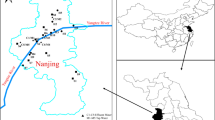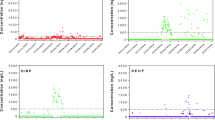Abstract
The water contaminations with organophosphate triesters (tri-OPEs) and diesters (di-OPEs) have recently provoked concern. However, the distributions of these compounds in natural water sources and artificial water treatment facilities are poorly characterized. A comprehensive study was therefore performed to measure their concentrations in a water source, a long-distance water pipeline, and a drinking water treatment plant (DWTP). Eight tri-OPEs and 3 di-OPEs were found to be widely distributed, with total concentrations in source water and pipelines ranging from 290.6 to 843.9 ng/L. The most abundant pollutants were tris(1-chloro-2-propyl) phosphate (TCPP), triethyl phosphate, tri-n-butyl phosphate (TnBP), and diphenyl phosphate (DPhP). Di-OPEs appeared to be removed less efficiently in the DWTP than the parent tri-OPEs, and the elimination efficiencies of tri-OPEs were structure-dependent. Long-distance pipeline transportation had no significant effect on the distributions of tri- and di-OPEs. Statistical analysis suggested that the sources of di-OPEs and the corresponding tri-OPEs differed, as did those of DPhP and di-n-butyl phosphate. A risk analysis indicated that tri-OPEs present limited ecological risks that are mainly due to TnBP and TCPP, and that the human health risks of tri-OPEs are negligible. However, di-OPEs (especially DPhP) may increase these risks. Further studies on the risks posed by di-OPEs in aquatic environments are therefore needed.




Similar content being viewed by others
References
Andresen, J., & Bester, K. (2006). Elimination of organophosphate ester flame retardants and plasticizers in drinking water purification. Water Research, 40, 621–629.
Azzouz, A., & Ballesteros, E. (2013). Influence of seasonal climate differences on the pharmaceutical, hormone and personal care product removal efficiency of a drinking water treatment plant. Chemosphere, 93, 2046–2054.
Björnsdotter, M. K., Romera-García, E., Borrull, J., de Boer, J., Rubio, S., & Ballesteros-Gómez, A. (2018). Presence of diphenyl phosphate and aryl-phosphate flame retardants in indoor dust from different microenvironments in Spain and the Netherlands and estimation of human exposure. Environment International, 112, 59–67.
Borrull, J., Colom, A., Fabregas, J., Borrull, F., & Pocurull, E. (2021). Presence, behaviour and removal of selected organic micropollutants through drinking water treatment. Chemosphere, 276, 130023.
Bourgin, M., Borowska, E., Helbing, J., Hollender, J., Kaiser, H.-P., Kienle, C., McArdell, C. S., Simon, E., & von Gunten, U. (2017). Effect of operational and water quality parameters on conventional ozonation and the advanced oxidation process O3/H2O2: Kinetics of micropollutant abatement, transformation product and bromate formation in a surface water. Water Research, 122, 234–245.
Choo, G., & Oh, J. E. (2020). Seasonal occurrence and removal of organophosphate esters in conventional and advanced drinking water treatment plants. Water Research, 186, 116359.
Cristale, J., Dantas, R. F., De Luca, A., Sans, C., Esplugas, S., & Lacorte, S. (2017). Role of oxygen and DOM in sunlight induced photodegradation of organophosphorous flame retardants in river water. Journal of Hazardous Materials, 323, 242–249.
Deng, M., Kuo, D. T. F., Wu, Q., Zhang, Y., Liu, X., Liu, S., Hu, X., Mai, B., Liu, Z., & Zhang, H. (2018). Organophosphorus flame retardants and heavy metals in municipal landfill leachate treatment system in Guangzhou. China. Environ. Pollut., 236, 137–145.
Fu, L., Du, B., Wang, F., Lam, J. C. W., Zeng, L., & Zeng, E. Y. (2017). Organophosphate triesters and diester degradation products in municipal sludge from wastewater treatment plants in China: Spatial patterns and ecological implications. Environmental Science and Technology, 51, 13614–13623.
Gong, X., Wang, Y., Pu, J., Zhang, J., Sun, H., & Wang, L. (2020). The environment behavior of organophosphate esters (OPEs) and di-esters in wheat (Triticum aestivum L.): Uptake mechanism, in vivo hydrolysis and subcellular distribution. Environment International, 135, 105405.
Hoffman, K., Daniels, J. L., & Stapleton, H. M. (2014). Urinary metabolites of organophosphate flame retardants and their variability in pregnant women. Environment International, 63, 169–172.
Hou, R., Xu, Y., & Wang, Z. (2016). Review of OPFRs in animals and humans: Absorption, bioaccumulation, metabolism, and internal exposure research. Chemosphere, 153, 78–90.
Hou, R., Huang, C., Rao, K., Xu, Y., & Wang, Z. (2018). Characterized in vitro metabolism kinetics of alkyl organophosphate esters in fish liver and intestinal microsomes. Environmental Science and Technology, 52, 3202–3210.
Kim, U. J., & Kannan, K. (2018). Occurrence and distribution of organophosphate flame retardants/plasticizers in surface waters, tap water, and rainwater: Implications for human exposure. Environmental Science and Technology, 52, 5625–5633.
Kim, U. J., Oh, J. K., & Kannan, K. (2017). Occurrence, removal, and environmental emission of organophosphate flame retardants/plasticizers in a wastewater treatment plant in New York State. Environmental Science and Technology, 51, 7872–7880.
Kojima, H., Takeuchi, S., Van den Eede, N., & Covaci, A. (2016). Effects of primary metabolites of organophosphate flame retardants on transcriptional activity via human nuclear receptors. Toxicology Letters, 245, 31–39.
Lai, N. L. S., Kwok, K. Y., Wang, X. H., Yamashita, N., Liu, G., Leung, K. M. Y., Lam, P. K. S., & Lam, J. C. W. (2019). Assessment of organophosphorus flame retardants and plasticizers in aquatic environments of China (Pearl River Delta, South China Sea, Yellow River Estuary) and Japan (Tokyo Bay). Journal of Hazardous Materials, 371, 288–294.
Lee, S., Jeong, W., Kannan, K., & Moon, H. B. (2016). Occurrence and exposure assessment of organophosphate flame retardants (OPFRs) through the consumption of drinking water in Korea. Water Research, 103, 182–188.
Li, J., He, J., Li, Y., Liu, Y., Li, W., Wu, N., Zhang, L., Zhang, Y., & Niu, Z. (2019). Assessing the threats of organophosphate esters (flame retardants and plasticizers) to drinking water safety based on USEPA oral reference dose (RfD) and oral cancer slope factor (SFO). Water Research, 154, 84–93.
Li, Y., Yao, C., Zheng, Q., Yang, W., Niu, X., Zhang, Y., & Lu, G. (2020). Occurrence and ecological implications of organophosphate triesters and diester degradation products in wastewater, river water, and tap water. Environmental Pollution, 259, 113810.
Lian, M., Lin, C., Wu, T., Xin, M., Gu, X., Lu, S., Cao, Y., Wang, B., Ouyang, W., Liu, X., & He, M. (2021). Occurrence, spatiotemporal distribution, and ecological risks of organophosphate esters in the water of the Yellow River to the Laizhou Bay, Bohai Sea. Science of the Total Environment, 787, 147528.
Liang, C., Peng, B., Wei, G. L., Gong, Y., Liu, G., Zeng, L., Liu, L. Y., & Zeng, E. Y. (2021). Organophosphate diesters in urban river sediment from south China: Call for more research on their occurrence and fate in field environment. ACS Environmental Science & Technology Water, 1, 871–880.
Liu, Y., Song, N., Guo, R., Xu, H., Zhang, Q., Han, Z., Feng, M., Li, D., Zhang, S., & Chen, J. (2018). Occurrence and partitioning behavior of organophosphate esters in surface water and sediment of a shallow Chinese freshwater lake (Taihu Lake): Implication for eco-toxicity risk. Chemosphere, 202, 255–263.
Liu, Y., Gong, S., Ye, L., Li, J., Liu, C., Chen, D., Fang, M., Letcher, R. J., & Su, G. (2021). Organophosphate (OP) diesters and a review of sources, chemical properties, environmental occurrence, adverse effects, and future directions. Environment International, 155, 106691.
Meyer, J., & Bester, K. (2004). Organophosphate flame retardants and plasticisers in wastewater treatment plants. Journal of Environmental Monitoring, 6, 599–605.
Nantaba, F., Palm, W. U., Wasswa, J., Bouwman, H., Kylin, H., & Kummerer, K. (2021). Temporal dynamics and ecotoxicological risk assessment of personal care products, phthalate ester plasticizers, and organophosphorus flame retardants in water from Lake Victoria, Uganda. Chemosphere, 262, 127716.
Pakalin, S.; Cole, T.; Steinkellner, J.; Nicolas, R.; Tissier, C.; Munn, S.; Eisenreich, S. Review on production processes of decabromodiphenyl ether (decaBDE) used in polymeric applications in electrical and electronic equipment, and assessment of the availability of potential alternatives to decaBDE. European Report EUR 22693 EN, Brussel, Belgium, 2007.
Park, H., Choo, G., Kim, H., & Oh, J. E. (2018). Evaluation of the current contamination status of PFASs and OPFRs in South Korean tap water associated with its origin. Science of the Total Environment, 634, 1505–1512.
Ren, H., Tröger, R., Ahrens, L., Wiberg, K., & Yin, D. (2020). Screening of organic micropollutants in raw and drinking water in the Yangtze River Delta, China. Environmental Sciences Europe, 32, 67.
Shi, Y., Gao, L., Li, W., Wang, Y., Liu, J., & Cai, Y. (2016). Occurrence, distribution and seasonal variation of organophosphate flame retardants and plasticizers in urban surface water in Beijing, China. Environmental Pollution, 209, 1–10.
Shoeib, T., Webster, G. M., Hassan, Y., Tepe, S., Yalcin, M., Turgut, C., Kurt-Karakuş, P. B., & Jantunen, L. (2019). Organophosphate esters in house dust: A comparative study between Canada, Turkey and Egypt. Science of the Total Environment, 650, 193–201.
Sim, W., Choi, S., Choo, G., Yang, M., Park, J. H., & Oh, J. E. (2021). Organophosphate flame retardants and perfluoroalkyl substances in drinking water treatment plants from Korea: Occurrence and human exposure. International Journal of Environmental Research and Public Health, 18, 2645.
Strobel, A., Letcher, R. J., Willmore, W. G., Sonne, C., & Dietz, R. (2018). Structure-dependent in vitro metabolism of alkyl-substituted analogues of triphenyl phosphate in East Greenland Polar Bears and Ringed Seals. Environmental Science & Technology Letters, 5, 214–219.
Su, G., Crump, D., Letcher, R. J., & Kennedy, S. W. (2014). Rapid in vitro metabolism of the flame retardant triphenyl phosphate and effects on cytotoxicity and mRNA expression in chicken embryonic hepatocytes. Environmental Science and Technology, 48, 13511–13519.
Su, G., Letcher, R. J., & Yu, H. (2016). Organophosphate flame retardants and plasticizers in aqueous solution: PH-dependent hydrolysis, kinetics and pathways. Environmental Science and Technology, 50, 8103–8111.
Tan, H., Yang, L., Yu, Y., Guan, Q., Liu, X., Li, L., & Chen, D. (2019). Co-existence of organophosphate di- and tri-esters in house dust from south China and midwestern United States: Implications for human exposure. Environmental Science and Technology, 53, 4784–4793.
Wang, D., Zhu, W., Chen, L., Yan, J., Teng, M., & Zhou, Z. (2018). Neonatal triphenyl phosphate and its metabolite diphenyl phosphate exposure induce sex- and dose-dependent metabolic disruptions in adult mice. Environmental Pollution, 237, 10–17.
Wang, Y., Yao, Y., Han, X., Li, W., Zhu, H., Wang, L., Sun, H., & Kannan, K. (2020). Organophosphate di- and tri-esters in indoor and outdoor dust from China and its implications for human exposure. Science of the Total Environment, 700, 134502.
Xing, L., Tao, M., Zhang, Q., Kong, M., Sun, J., Jia, S., & Liu, C. H. (2020). Occurrence, spatial distribution and risk assessment of organophosphate esters in surface water from the lower Yangtze River Basin. Science of the Total Environment, 734, 139380.
Xu, L., Hu, Q., Liu, J., Liu, S., Liu, C., Deng, Q., Zeng, X., & Yu, Z. (2019). Occurrence of organophosphate esters and their diesters degradation products in industrial wastewater treatment plants in China: Implication for the usage and potential degradation during production processing. Environmental Pollution, 250, 559–566.
Xu, L., Zhang, B., Hu, Q., Liu, Y., Shang, T., Zeng, X., & Yu, Z. (2021). Occurrence and spatio-seasonal distribution of organophosphate tri- and di-esters in surface water from Dongting Lake and their potential biological risk. Environmental Pollution, 282, 117031.
Zhang, Z., Shao, H., Wu, M., Zhang, J., Li, D., Li, J., Wang, H., Shi, W., & Xu, G. (2019). Occurrence, distribution, and potential sources of organophosphate esters in urban and rural surface water in Shanghai, China. Archives of Environmental Contamination and Toxicology, 77, 115–126.
Zhang, Q., Yu, C., Fu, L., Gu, S., & Wang, C. (2020). New Insights in the endocrine disrupting effects of three primary metabolites of organophosphate flame retardants. Environmental Science and Technology, 54, 4465–4474.
Zhang, S., Li, Y., Yang, C., Meng, X. Z., Zheng, H., Gao, Y., & Cai, M. (2021). Application of Hi-throat/Hi-volume SPE technique in analyzing occurrence, influencing factors and human health risk of organophosphate esters (OPEs) in drinking water of China. Journal of Environmental Management, 291, 112714.
Zhong, W., Cui, Y., Li, R., Yang, R., Li, Y., & Zhu, L. (2021). Distribution and sources of ordinary monomeric and emerging oligomeric organophosphorus flame retardants in Haihe Basin, China. Science of the Total Environment, 785, 147274.
Acknowledgements
The presented study was partially supported by National Science Foundation Project of China (51678351) and by Project “Health effect of municipal tap water based on direct drinking target (19DZ1204404)”.
Funding
Fund was provided by National Natural Science Foundation of China 51678351 and 19DZ1204404
Author information
Authors and Affiliations
Contributions
XZ contributed to methodology, funding acquisition, supervision, and writing and review. YB contributed to methodology, visualization, and writing—original draft. MF performed investigation and data curation. XZ contributed to resources, validation, and data curation. BL contributed to methodology and validation. XH contributed to funding acquisition and resources. ZZ performed conceptualization, writing—review and editing, and supervision.
Corresponding author
Ethics declarations
Conflict of interest
We declared that we have no known competing financial interests or personal relationships that could have appeared to influence the work reported in this paper.
Ethical approval
We assured that this study did not involve any ethical experiments.
Consent for publication
Depending on the ownership of the journal and its policies, we will grant the Publisher an exclusive license to publish the article or transfer copyright of the article to the Publisher.
Additional information
Publisher's Note
Springer Nature remains neutral with regard to jurisdictional claims in published maps and institutional affiliations.
Supplementary Information
Below is the link to the electronic supplementary material.
Rights and permissions
Springer Nature or its licensor holds exclusive rights to this article under a publishing agreement with the author(s) or other rightsholder(s); author self-archiving of the accepted manuscript version of this article is solely governed by the terms of such publishing agreement and applicable law.
About this article
Cite this article
Zhang, X., Bi, Y., Fu, M. et al. Organophosphate tri- and diesters in source water supply and drinking water treatment systems of a metropolitan city in China. Environ Geochem Health 45, 2401–2414 (2023). https://doi.org/10.1007/s10653-022-01333-6
Received:
Accepted:
Published:
Issue Date:
DOI: https://doi.org/10.1007/s10653-022-01333-6




